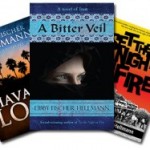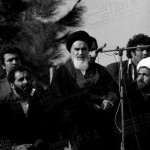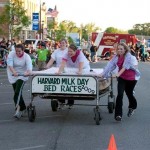 I’ve been trying to figure out why I love doing research—much more than writing, btw—and I finally think I have an answer. Research is a free-form activity, especially on the internet. I Google a topic, scan a few articles, and if something catches my fancy, I click on the link or do another Google search to find out more about it.
I’ve been trying to figure out why I love doing research—much more than writing, btw—and I finally think I have an answer. Research is a free-form activity, especially on the internet. I Google a topic, scan a few articles, and if something catches my fancy, I click on the link or do another Google search to find out more about it.
For me, research is the purest form of learning, short of plowing through the textbooks and syllabi we were assigned in school or university. Because I decide what I’ll read and study, I am empowered. I choose the topic. I make the analysis. I decide whether it’s relevant. I fall through the wormhole of history, content to explore what I want, make side-trips, and generally get lost in the other times and other places. It’s incredibly seductive.
However, at some point, an idea for a story floats to the surface. It might be the period I want to write about; an event that represented a seminal change in society at a particular time; or perhaps a character who demands that I pay attention to her or him. After almost twenty years of writing, I’ve realized I need to pay attention to those red flags.
That’s when I start my real “research process,” which follows.
The Fun Part
 Once I have an idea of the time period I want to write about, I make a list of the fiction and nonfiction books that have been written about that period, and I read them. I take copious notes from all the books, but I fact check the fictional ones to make sure they’re accurate. When I wrote A Bitter Veil, for example, I read about 20 books all told.
Once I have an idea of the time period I want to write about, I make a list of the fiction and nonfiction books that have been written about that period, and I read them. I take copious notes from all the books, but I fact check the fictional ones to make sure they’re accurate. When I wrote A Bitter Veil, for example, I read about 20 books all told.
Visual Records
Because most of my historical novels are set in recent history, ie the 20th century, I’ll go on the internet to see if there’s any film about the time period. Usually, there is.  For example, I found film of Ayatollah Khomeini’s return to Tehran and the speech he made at a Tehran cemetery. Of course, I don’t speak Farsi, but just watching his body language, face, and listening to his intonation told me a lot about the man. The same was true with Fidel Castro and Che Guevara in my Cuban set thriller, Havana Lost. I must have watched 6 or 7 films about Cuba, set during the revolution and after. And, of course, there were enormous amounts of footage of the 1960’s and the Democratic National Convention for Set The Night On Fire (some of which, btw, I got the rights to use in the video trailer).
For example, I found film of Ayatollah Khomeini’s return to Tehran and the speech he made at a Tehran cemetery. Of course, I don’t speak Farsi, but just watching his body language, face, and listening to his intonation told me a lot about the man. The same was true with Fidel Castro and Che Guevara in my Cuban set thriller, Havana Lost. I must have watched 6 or 7 films about Cuba, set during the revolution and after. And, of course, there were enormous amounts of footage of the 1960’s and the Democratic National Convention for Set The Night On Fire (some of which, btw, I got the rights to use in the video trailer).
Visual records include photographs. Since I was a video producer in another life, photos have a huge impact on me. It’s not just the subject of the photo; it’s also the time of day it was shot, the contrast, and what is happening in the background of the shot. All those factors have a bearing on how I will eventually describe the setting.
Articles
The next step is to follow up on the internet with articles that are focused on the specific time period and place I’m going to write about. I print them out, highlight salient points, and take notes. By then, I’m starting to get a picture of the time period, the conflicts, the stakes, and what really happened. Similar patterns emerge and I feel more confident that I understand the gestalt of events.
Primary Research
 That’s when I switch to primary research. If possible, I visit the setting itself. I went to Cuba, for example, for Havana Lost; I lived through the Sixties. I went down to the U of Chicago to research the early years of the Manhattan Project for The Incidental Spy; I went to Lawndale and toured the neighborhood when I wrote An Eye For Murder.
That’s when I switch to primary research. If possible, I visit the setting itself. I went to Cuba, for example, for Havana Lost; I lived through the Sixties. I went down to the U of Chicago to research the early years of the Manhattan Project for The Incidental Spy; I went to Lawndale and toured the neighborhood when I wrote An Eye For Murder.
If it’s not possible to actually travel to the place, I look for at least 5 people I can interview who lived through the time period or event, or whose relatives did. I make a list of questions, most of which are fairly mundane, For example, what did people wear? What did they eat? What was the most important part of the day? What was it like to live in that place? Were you happy? Complacent? Unsettled? I try to tape those interviews so I have them close at hand. Even if I have visited the setting, I’ll still try to find people who are from the area or whose parents were.
Writing the Draft
Finally I’m ready to start writing. During the process, new questions always come up, so I’ll call or interview the people I spoke to previously to nail down facts. If that’s not possible, I’ll Google several sources, until I am comfortable that I have a reasonable facsimilie of the truth.
Plot Possibilities
The most satisfying part of the research is that it often leads to interesting plot points I’d never considered. That’s happened in all my historical novels. In  An Image of Death, for example, I needed to create the backstory for a character who was from Armenia and grew up under Communism. I found out there was a huge earthquake in Armenia in 1988, so bad that Soviet soldiers were called in to help with the aftermath. But they didn’t have the right equipment, and the rescuers got sick and had to be rescued . That’s how my character, Arin, met the man whom she subsequently married. He was a Soviet Army officer in the hospital, and she was a volunteer.
An Image of Death, for example, I needed to create the backstory for a character who was from Armenia and grew up under Communism. I found out there was a huge earthquake in Armenia in 1988, so bad that Soviet soldiers were called in to help with the aftermath. But they didn’t have the right equipment, and the rescuers got sick and had to be rescued . That’s how my character, Arin, met the man whom she subsequently married. He was a Soviet Army officer in the hospital, and she was a volunteer.
Before I send out the book for editing, I make sure one or two of the people I interviewed read the manuscript to make sure I didn’t get anything wrong. If that’s not possible, and I haven’t visited the place myself, I’ll seek out someone in academia to review the manuscript for accuracy. My nightmare fantasy is a reader who throws my book across the room, saying, “She doesn’t know what she’s talking about.”
 So far, that hasn’t happened, at least in a big way. I did get an email from a reader of my first novel, An Eye For Murder, who told me I’d made a big mistake. I’d called an event that started during World War Two in Harvard, Illinois, “Milk Days.” I was wrong, she claimed. “It was ‘Milk Day,” not “Milk Days.” How did she know? Her father was the mayor of Harvard when the event was first launched.
So far, that hasn’t happened, at least in a big way. I did get an email from a reader of my first novel, An Eye For Murder, who told me I’d made a big mistake. I’d called an event that started during World War Two in Harvard, Illinois, “Milk Days.” I was wrong, she claimed. “It was ‘Milk Day,” not “Milk Days.” How did she know? Her father was the mayor of Harvard when the event was first launched.
I apologized.
